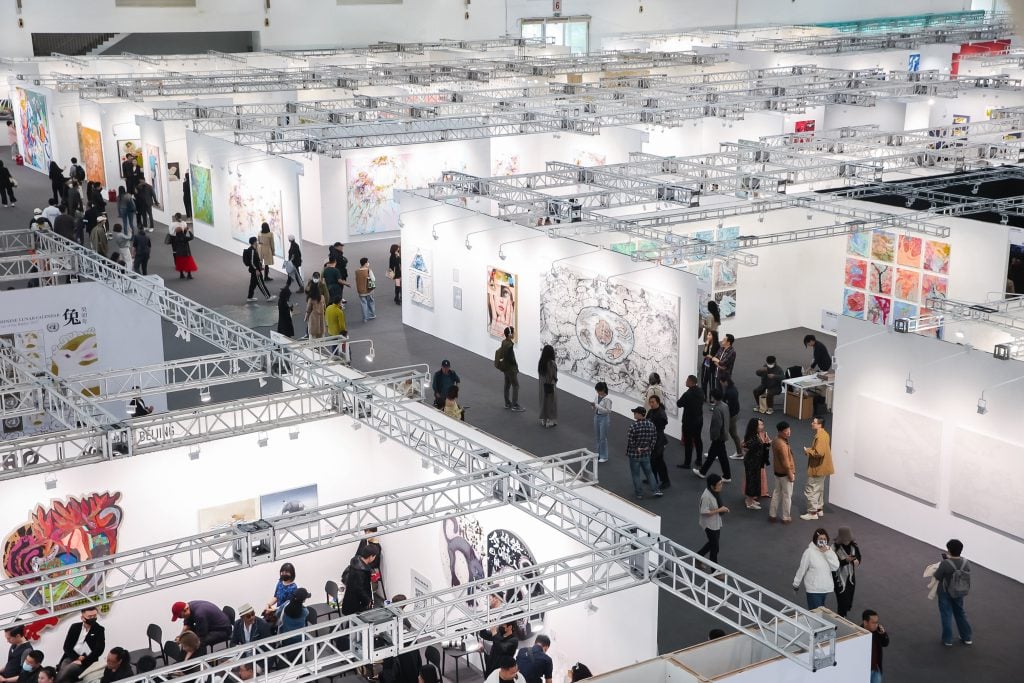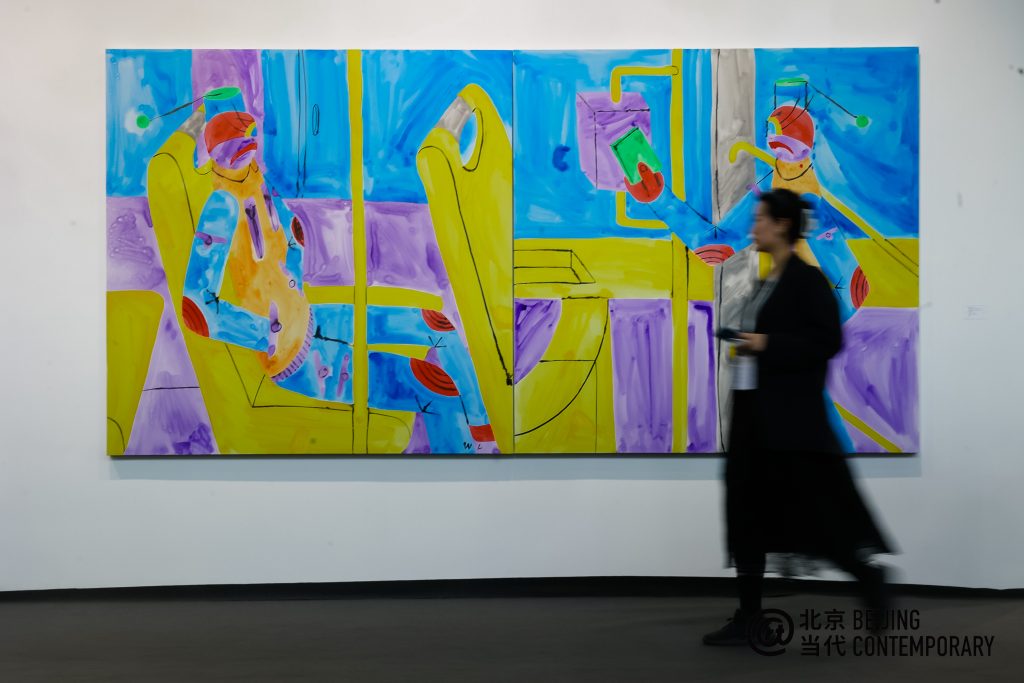Gallery Network
Director Bao Dong on What Makes the Beijing Contemporary Uniquely Situated to Be the Next Top Art Fair
In less than a decade, the fair has emerged as an important event on the international art world calendar.

In less than a decade, the fair has emerged as an important event on the international art world calendar.

Artnet Gallery Network

Next May, the esteemed art fair Beijing Dangdai, also known as Beijing Contemporary, will return for its 6th edition in Hall 11 of the city’s National Agricultural Exhibition Center. Reflecting the core mission and ethos of the fair, the 2024 edition of Beijing Dangdai 2024 will host a dynamic and diverse range of international galleries and see the fair collaborate with art and cultural institutions both from across the Chinese city and from around the world.
Founded in 2018 and helmed by Art Director Bao Dong, in six short years Beijing Dangdai has emerged as a leading international art fair and an important event on art world calendars. We reached out to Bao Dong to learn more about what inspired him to establish the fair, and what sets it apart within the contemporary “art ecosystem.”

Courtesy of Beijing Contemporary.
Why did you choose Beijing to launch this art fair?
Beijing served as the capital city for five dynasties in China, since some 850 years ago, laying the foundation for people of different regions, ethnic groups, and cultural backgrounds to gather and interact. It has a unique climate that boasts the most energetic and widest spectrum of art ecosystems in China, and is home to the largest number of artists, galleries, art institutes, and is a hub for both corporate and private collectors.
It also boasts a profound and historic heritage that is constantly intertwining with the dynamic vigor of contemporary art and artists. Established over two decades ago, the 798 Art Zone is now a landmark in the city with the highest density of art galleries, museums, and artist studios with international art and culture institutions like Galleria Continua, Galerie Urs Meile, Whitestone Gallery, and Goethe Institute. International galleries such as Lisson Gallery and Massimodecarlo flocked to the bonded-area in close proximity to the airport. Also, the prestigious art institution UCCA is headquartered in Beijing, along with most numbered museums opened by private individuals, financial institutions, and Chinese auction houses such as Poly Auction and China Guardian Auctions.
The juxtapositions inherent in the city are evidenced in intriguing exhibitions like “Mirroring the Heart of Heaven and Earth: Ideas and Images in the Chinese Study” on view at the Palace Museum, showcasing contemporary and multimedia artworks with classical calligraphies, paintings, and antique collections. The launch of Beijing Dangdai Art Fair in 2018 was a direct response to the growing need for and interest in a Beijing-specific perspective on contemporary art.

Courtesy of Beijing Contemporary.
What makes Beijing Dangdai art fair stand out from other art fairs in China and abroad?
Whilst the art market may be seen as “flattened” and homogenized, Beijing Dangdai presents its “unevenness” in its participating galleries and exhibition design, bringing together the blood and vessels that are scattered around the art landscapes of the capital city and beyond.
Among the 84 Chinese galleries that participated in our 2023 edition, 75 percent of participants have spaces in Beijing, showing the pivotal status of the city within China. Among the 87 participating galleries that have spaces in China, 10 have gallery spaces in emerging cities such as Shenzhen, Chengdu, and Urumqi.
Booth layout is planned counter to the hierarchical arrangement often adopted, as galleries of different backgrounds and seniority are scattered around the fair space to share the main area.
Our “Value” sector features a curation of galleries and the diverse values they embody. Established galleries from different regions and backgrounds will present world-class artworks in this sector. “Future” seeks to discover and foresee future art trends through presenting forward-thinking artworks. Galleries will bring experimental and curated art pieces and projects that explore new presentation methods and artistic concepts.
“Story” is a curatorial sector of the fair, meant to be realized via museum-level exhibitions at various exhibiting spaces in Beijing, probing into the contemporary art scene with in-depth perspective and rigorous academic scope,.

Courtesy of Beijing Contemporary.
Compared to art collectors in other cities, what’s different about Beijing-based collectors?
Beijing has the most collectors per capita in the country, consisting of both experienced and younger individuals with highly personalized paths to their collections. Each collection is formulated by high consumer power, century-long antiques collection history, and in-depth appreciation for content rather than format.
The threads and stories of their collections are closely related to their life experience, knowledge structures, and aesthetic preferences, highlighting their personal tastes and visions.
Some collectors look to history as a reference, and aspire to build a micro art history of their own. Some take delight in the surprises and contrasts of collecting both ancient and contemporary art; some see art collection as their life cause and devote time, energy, and resources to enjoy the most of it.
As such, it is then not uncommon to see collectors in flip-flops at Beijing Dangdai, who come to the fair with their families on public days. They come for the sake of art and want to celebrate it with jubilation rather than see it as a means to socialize or flaunt themselves.

Courtesy of Beijing Contemporary.
What are the most impressive trends in the art ecology that have emerged over the recent editions of the fair?
More and more galleries active in China have begun to represent artists from around the globe. Promising international artists appear in the artist lists from native Chinese art galleries like Antenna Space, Star Gallery, White Space, and Simulacra.
Likewise, Chinese galleries have also begun to open new spaces outside the country. For instance, with spaces in both Beijing and Berlin, gallerist Hua Xiaochan from Hua International said to have faith in the potential of Chinese artists and the universal value of art that transcends borders and cultures. She works closely with emerging artists both in China and Europe to build strong and long-term relationships with active and emerging art collectors.
Beijing Dangdai will continue to gather a diverse line-up of galleries and collaborate with art and cultural institutions across Beijing and beyond to present the audience with a vibrant and dynamic spectrum of the art ecosystem. We cordially invite you to “Tune into the artworld of Beijing.”
Beijing Contemporary VIP Preview will take place May 23–24, with public days May 25–26, in Hall 11 of the National Agricultural Exhibition Center.